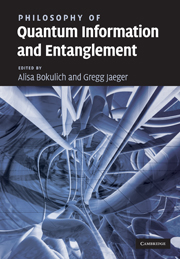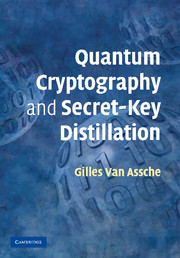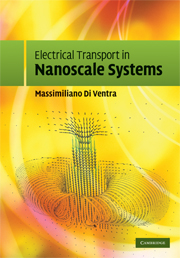Refine search
Actions for selected content:
3361 results in Quantum Physics, Quantum Information and Quantum Computation
Appendix 4 - Number theory
- from Appendices
-
- Book:
- Quantum Computation and Quantum Information
- Published online:
- 05 June 2012
- Print publication:
- 09 December 2010, pp 625-639
-
- Chapter
- Export citation
11 - Entropy and information
- from Part III - Quantum information
-
- Book:
- Quantum Computation and Quantum Information
- Published online:
- 05 June 2012
- Print publication:
- 09 December 2010, pp 500-527
-
- Chapter
- Export citation
Frontmatter
-
- Book:
- Quantum Computation and Quantum Information
- Published online:
- 05 June 2012
- Print publication:
- 09 December 2010, pp i-viii
-
- Chapter
- Export citation
Appendix 2 - Group theory
- from Appendices
-
- Book:
- Quantum Computation and Quantum Information
- Published online:
- 05 June 2012
- Print publication:
- 09 December 2010, pp 610-616
-
- Chapter
- Export citation
9 - Distance measures for quantum information
- from Part III - Quantum information
-
- Book:
- Quantum Computation and Quantum Information
- Published online:
- 05 June 2012
- Print publication:
- 09 December 2010, pp 399-424
-
- Chapter
- Export citation
Part III - Quantum information
-
- Book:
- Quantum Computation and Quantum Information
- Published online:
- 05 June 2012
- Print publication:
- 09 December 2010, pp -
-
- Chapter
- Export citation
6 - Quantum search algorithms
- from Part II - Quantum computation
-
- Book:
- Quantum Computation and Quantum Information
- Published online:
- 05 June 2012
- Print publication:
- 09 December 2010, pp 248-276
-
- Chapter
- Export citation
1 - Introduction and overview
- from Part I - Fundamental concepts
-
- Book:
- Quantum Computation and Quantum Information
- Published online:
- 05 June 2012
- Print publication:
- 09 December 2010, pp 1-59
-
- Chapter
- Export citation
Introduction to the Tenth Anniversary Edition
-
- Book:
- Quantum Computation and Quantum Information
- Published online:
- 05 June 2012
- Print publication:
- 09 December 2010, pp xvii-xviii
-
- Chapter
- Export citation
Part I - Fundamental concepts
-
- Book:
- Quantum Computation and Quantum Information
- Published online:
- 05 June 2012
- Print publication:
- 09 December 2010, pp -
-
- Chapter
- Export citation
Preface
-
- Book:
- Quantum Computation and Quantum Information
- Published online:
- 05 June 2012
- Print publication:
- 09 December 2010, pp xxi-xxvi
-
- Chapter
- Export citation
Nomenclature and notation
-
- Book:
- Quantum Computation and Quantum Information
- Published online:
- 05 June 2012
- Print publication:
- 09 December 2010, pp xxix-xxxii
-
- Chapter
- Export citation
Appendix 3 - The Solovay–Kitaev theorem
- from Appendices
-
- Book:
- Quantum Computation and Quantum Information
- Published online:
- 05 June 2012
- Print publication:
- 09 December 2010, pp 617-624
-
- Chapter
- Export citation

Philosophy of Quantum Information and Entanglement
-
- Published online:
- 04 August 2010
- Print publication:
- 10 June 2010

Quantum Cryptography and Secret-Key Distillation
-
- Published online:
- 04 August 2010
- Print publication:
- 29 June 2006

Electrical Transport in Nanoscale Systems
-
- Published online:
- 06 July 2010
- Print publication:
- 07 August 2008
2 - Entanglement and subsystems, entanglement beyond subsystems, and all that
- from Part I - Quantum entanglement and non-locality
-
-
- Book:
- Philosophy of Quantum Information and Entanglement
- Published online:
- 04 August 2010
- Print publication:
- 10 June 2010, pp 16-43
-
- Chapter
- Export citation
11 - Quantum computation: Where does the speed-up come from?
- from Part IV - Quantum communication and computing
-
-
- Book:
- Philosophy of Quantum Information and Entanglement
- Published online:
- 04 August 2010
- Print publication:
- 10 June 2010, pp 231-246
-
- Chapter
- Export citation
3 - Formalism locality in quantum theory and quantum gravity
- from Part I - Quantum entanglement and non-locality
-
-
- Book:
- Philosophy of Quantum Information and Entanglement
- Published online:
- 04 August 2010
- Print publication:
- 10 June 2010, pp 44-62
-
- Chapter
- Export citation
6 - What probabilities tell about quantum systems, with application to entropy and entanglement
- from Part II - Quantum probability
-
-
- Book:
- Philosophy of Quantum Information and Entanglement
- Published online:
- 04 August 2010
- Print publication:
- 10 June 2010, pp 127-150
-
- Chapter
- Export citation
